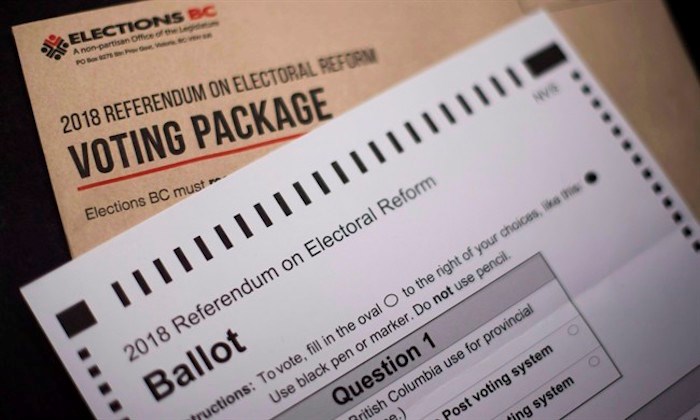Santa Claus may well deliver the most pressing political news of the year in B.C. — that of the electoral reform mail-in referendum.
“Reporting the results as soon as possible is a priority for us and we hope to be able to report results before Christmas,” said Elections BC spokesperson Andrew Watson.
 The 2018 Referendum on Electoral Reform package and mail in ballot from Elections B.C. is pictured in North Vancouver, B.C., Thursday, Nov. 1, 2018. As residents of the province vote in an ongoing referendum on electoral reform, the Vote No side is cautioning that the system would allow extremists to be elected with a tiny percentage of votes and hold the balance of power with “disastrous results.” THE CANADIAN PRESS /Jonathan Hayward
The 2018 Referendum on Electoral Reform package and mail in ballot from Elections B.C. is pictured in North Vancouver, B.C., Thursday, Nov. 1, 2018. As residents of the province vote in an ongoing referendum on electoral reform, the Vote No side is cautioning that the system would allow extremists to be elected with a tiny percentage of votes and hold the balance of power with “disastrous results.” THE CANADIAN PRESS /Jonathan Hayward
“That said, how fast we are able to do this depends on turnout and the speed at which we are able to process completed voting packages,” he added.
Ballots are due in mailboxes by Dec. 7, a week later than expected due to a Canada Post workers’ strike.
To date, 37 % of registered voters have sent in their ballots. Well over one million ballots are expected to be counted in a secure, secret Great Victoria location by 60 to 70 Elections BC staff, Watson said.
The counting system is more complex than an election where voting officials hand out a ballot that is then cast. Here, the voting envelopes, including signatures, must be verified as valid before the ballots are extracted and counted by computer, starting Dec. 1. When deemed necessary, officials may contact some voters to verify information on their envelopes.
“It will take time to screen returned voting packages to ensure the requirements of the regulation governing the referendum have been met, and to separate the different elements of the voting package in preparation for tabulating the results,” Watson said.
Where voters requested a replacement ballot, those ballots will only be counted after Dec. 7 to ensure duplicate packages are not included in the count.
The computing technology is similar to that used in Ontario’s recent provincial election. While Ontario experienced some issues with its computers, Elections Ontariosaid it had offered no advice to B.C. If a machine cannot read ballots, they will be reviewed manually.
If the computer rejects a ballot, staff will review it. If staff cannot determine voter intent, it will be deemed spoiled.
Once the results are finalized, they will be released to the speaker of the B.C. Legislature and to the public via the Elections BC website, social media channels, and a news release.
Voters were first asked to either choose to keep the current first-past-the-post (FPTP) provincial electoral system or switch to proportional representation (PR). With a second question they were asked to rank three PR systems.
If more than half the votes support PR, the PR system with the most support (by way of the second question) will be adopted.
If the second question is somehow spoiled on a ballot, it does not affect the first question, Watson said.
And, “The number of responses to Question 2 will not affect the results of Question 1. Question 1 is counted as a simple majority whatever the response to Question 2 is,” he said.
The ballots will not be scrutinized by partisan organizations. Bill Tieleman, president of No Proportional Representation Society of B.C., said his group will likely have observers pass through the Elections BC counting rooms, not unlike what occurred with the HST referendum vote count.
But considering over 100,000 ballots will be counted daily, “It would be rather challenging to scrutinize” the counting, said Tieleman.
In the 2011 HST referendum, observers swore an oath not to publicly disclose the proceedings they were observing, according to Elections BC.
A Nov. 20 poll by Research Co. indicates a dead heat in results, with 40 % supporting first-past-the-post and proportional representation, each respectively and 15 % undecided (5 % choosing not to vote). Younger and more urban residents were more likely to support PR. And according to a Nov. 8 Mainstreet poll, Mixed Member Proportional has 44 % support among the three choices outlined on the ballot.
With turnout sitting at 34 % on Nov. 29, Tieleman questioned whether a low turnout should be valid. He declined to give a number he thinks is appropriate. BC Liberal leader Andrew Wilkinson said 40 % should legitimize the results.
The HST mail-in referendum had a 52.6 % turnout while prior electoral reform referendums (conducted at polling stations during general elections) in 2009 and 2005 had turnouts of 55 % and 61 %.


